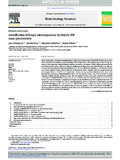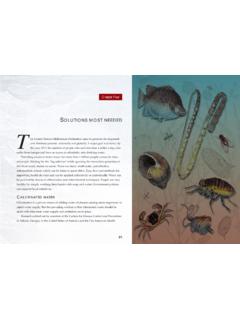Transcription of Applications of small molecule activators and …
1 Applications of small moleculeactivators and inhibitors of quorumsensing in Gram-negative bacteriaWarren Galloway1, James T. Hodgkinson1,2, Steven Bowden2,Martin Welch2and David R. Spring11 Department of Chemistry, University of Cambridge, Cambridge, CB2 1EW, United Kingdom2 Department of Biochemistry, University of Cambridge, Cambridge, CB2 1EW, United KingdomQuorum sensing is a form of intercellular communica-tion used by many species of bacteria that facilitatesconcerted interactions between the cells comprising apopulation. The phenotypes regulated by quorum sen-sing are extremely diverse, with many having a signifi-cant impact upon healthcare, agriculture, and theenvironment.
2 Consequently there has been significantinterest in developing methods to manipulate this sig-nalling process and recent years have witnessed signifi-cant theoretical and practical developments. A widerange of small molecule modulators of quorum sensingsystems has been discovered, providing an expansivechemical toolbox for the study and modulation of thissignalling mechanism. In this review, a selection ofrecent case studies which illustrate the value of bothactivators and inhibitors of quorum sensing in Gram-negative bacteria are of quorum sensingQuorum sensing is mediated by small diffusible signallingmolecules termed autoinducers. These are synthesisedintracellularly by bacterial cells throughout their growthand are continually released into the surrounding milieu;consequently, autoinducers typically accumulate in propor-tion to the cell density of the bacterial population [1].
3 Oncethe extracellular concentration of autoinducer reaches acertain threshold level (at which point the population isconsidered to be quorate ), a signal transduction cascade istriggered leading to population-wide changes in geneexpression and the initiation of co-operative behavioursthat benefit the community as a whole [1 7]. Betweendifferent bacterial species there is variation in one or moreaspects of this signalling process, that is, the exact nature ofthe chemical signals, receptors, mechanisms of signal trans-duction, and phenotypic consequences [1,8] . Nevertheless,with regard to intraspecies communication, most Gram-negative bacteria use quorum sensing systems which utiliseone of two distinct types of small molecule autoinducer [1].
4 N-acylated-L-homoserine lactones (AHLs) are the most com-mon class of autoinducer used by Gram-negative are produced by LuxI-type synthase enzymes and bindto cytoplasmic LuxR-type receptors to exert a regulatoryoutput [9] . Cyclic peptides are the major class of autoinducerin Gram-positive bacteria. These are recognised by eithermembrane-associated histidine kinases or cytoplasmicreceptors [9] . Recently, a family of molecules genericallytermed autoinducer-2 (AI-2) has been discovered. It hasbeen suggested that AI-2 is a non-species specific autoindu-cer, capable of mediating intra- and interspecies commu-nication among Gram-negative and Gram-positive bacteria(Figure 1) [1,10 12].
5 The dependency of quorum sensing upon a language ofautoinducers provides the chemical opportunity to manip-ulate this signalling process at a molecular level usingnon-native compounds [1,13,14]. Indeed, recent years havewitnessed significant efforts directed towards the discoveryof molecules capable of interfering with various componentsof the quorum sensing communication circuit (Box 1) [1] .In this review we describe some quorum sensing-regu-lated behaviours that have significant impacts uponhuman healthcare, agriculture, and the discussion is primarily focused upon the phenotypesof Gram-negative bacteria regulated by AHL-based signal-ling, as this represents the most thoroughly studied andbest-understood class of quorum sensing systems [1] (for adiscussion of intercellular signalling in Gram-positive bac-teria the reader is directed towards some recent specialisedreviews [9,15]).
6 The potential real-world value of smallmolecule modulators of the relevant quorum sensing sys-tems is highlighted, with a particular emphasis uponcompounds which are thought to act via interaction withLuxR-type receptor proteins (Box 2 and Box 3). Wherepossible, examples of such agents are provided, with afocus upon most recent developments. Overall, these casestudies provide a clear and timely illustration of the wide-ranging importance of quorum sensing and the significantpromise offered by small molecule activators or inhibitorsof this form of intercellular sensing and human healthcareNumerous species of clinically relevant pathogenic bac-teria use quorum sensing systems to regulate processesassociated with virulence [16,17].
7 This allows the bacterialcells to multiply without displaying overt virulent beha-viour until a certain threshold population density isreached [17]. Consequently, a coordinated attack on theReviewCorresponding author: Spring, bacteria; communication; quorum sensing; $ see front matter 2012 Elsevier Ltd. All rights reserved. Trends in Microbiology, September 2012, Vol. 20, No. 9 449host (or on a competing microorganism) is only made whenthe bacterial population is high, which increases the like-lihood that any defences will be successfully overwhelmed,thereby enhancing the survival prospects of the bacteria[18,19].Given the link between quorum sensing and virulence,it is unsurprising that disruption of this signalling processhas emerged as an attractive new therapeutic strategy forthe treatment of a variety of human infections caused bybacteria [1,17,20 22].
8 The inhibition of quorum sensing iscommonly referred to as quorum quenching . The expres-sion was originally coined to describe the disruption ofGram-negative quorum sensing resulting from the enzy-matic hydrolysis of AHL autoinducers [23]. However, overthe course of the past decade this definition has evolved;the phrase quorum quenching is now commonly used in amore general sense to refer to any inhibition of quorumsensing ( , inhibition resulting from both enzymatic andNHOOOHOOdDHLNHOOOHBHLNHOOHPQSNHOOOHOO OHLOOBOOHHOHOHOS-THMF-borateOOHHOHOHOR-T HMFOSSHNONHONHOHOOCHNOHNOHONHOHNOHOH2 NHOAIP-1 TRENDS in Microbiology Figure 1. Selected natural quorum sensing autoinducers.)
9 BHL, OdDHL and OOHL are examples of the N-acylated-L-homoserine lactone (AHL) class of autoinducers. BHL,OdDHL and PQS are native quorum sensing molecules in the Gram-negative bacterium Pseudomonas aeruginosa. OOHL is a signalling molecule in the Gram-negativebacterium Agrobacterium tumefaciens. AIP-1 is an example of the cyclic peptide class of autoinducers employed by Gram-positive bacteria (in this case, Staphylococcusaureus). (2S, 4S)-2-methyl-2,3,3,4-tetrahydroxytetrahy drofuran-borate (S-THMF-borate) and (2R, 4S)-2-methyl-2,3,3,4-tetrahydroxytetrahy drofuran (R-THMF) are known AI-2signalling compounds, which can interconvert with each other via a complex equilibrium process.
10 S-THMF-borate is commonly referred to as AI-2 in the : BHL, N-butanoyl-L-homoserine lactone; OdDHL, N-(3-oxododecanoyl)-L-homoserine lactone; OOHL, N-3-oxooctanoyl-L-homoserine lactone; PQS,Pseudomonas quinolone signal; AIP-1. autoinducing peptide 1. small molecule intervention of AHL quorum sensing systems: potential targetsThere are three core components of all AHL-based quorum sensingsystems: (i) the LuxI-type synthase (which generates the signallingmolecule); (ii) the AHL signalling molecule itself; and (iii) the LuxR-type receptor protein (which binds to the signalling molecule ). Inprinciple, each of these components represents a possible target forexternal intervention using small molecules [1,13].



